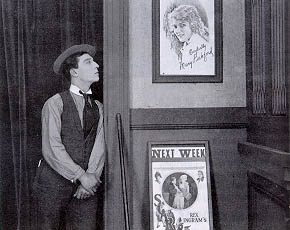Bernard ran into an old friend this week.
Wednesday, March 17, 2010
Thursday, March 11, 2010
Max Davison in "The Call of the Cuckoo" (1927)
This comedy shows a bit more of the range of the period - especially since it's built on a kind of stereotyped portrayal of Jewish characters.
Harry Langdon - Long Pants
Another great comic of the period, Harry Langdon - here in a very dark comedy.
Chaplin - The Great Dictator (1940) - The Final Scene
As the Jewish barber Schulz who impersonates the anti-semitic dictator Hynkel, Chaplin gives his own political speech to a world on the brink of World War II.
Chaplin - The Great Dictator (1940) - Hynkel's speech
With The Great Dictator, Chaplin used sound to add to his satirical portrayal of Adolf Hitler as the petty tyrant Adenoid Hynkel. Very broad comedy, hilarious stuff - and it got him to trouble years later when members of the House UnAmerican Activities Committee determined that he had been "prematurely hostile" to fascism and the Nazis.
Chaplin - Modern Times (1936) - The Waiter's Song
Ana amazing event for the contemporary audience - Charlie sings.
Chaplin - Modern Times (1936) - The Factory
The classic scene from Modern Times- The Tramp is now a worker, driven mad by the machine rhythms of factory work.
Chaplin - The Idle Class (1921)
In "The Idle Class," Chaplin tells a sentimental, 19th-century sort of story abut crossing lines of class.
Chaplin - The Immigrant (1917)
"The Immigrant" shows Chaplin's consistent identification with the diverse immigrant population of the United States - his sense that "the people" really meant the people rejected and exploited by those with power.
Chaplin - The Police (1916)
Many of Chaplin's early comedies are available online, in versions of varying quality.
"Police" shows that Chaplin introduced social and political themes from early in his career.
Friday, March 5, 2010
This Just In
Nosferatu at American Art Museum
We'll see a bit of Nosferatu in just a few weeks, in our sessions on German silent film.
Subscribe to:
Posts (Atom)


